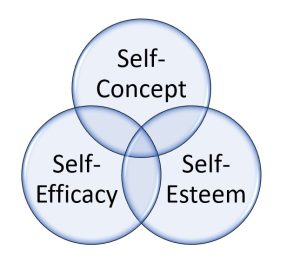2.3 Perceiving and Presenting Self
Learning Objectives
- Define self-concept and discuss how we develop our self-concept.
- Define self-esteem and discuss how we develop self-esteem.
- Explain how social comparison theory influences self-perception.
- Discuss how social norms, family, culture, and media influence self-perception.
- Define self-presentation and discuss common self-presentation strategies.
Just as our perception of others affects how we communicate, so does our perception of ourselves. But what influences our self-perception? How much of our self is a product of our own making and how much of it is constructed based on how others react to us? How do we present ourselves to others in ways that maintain our sense of self or challenge how others see us? We will begin to answer these questions in this section as we explore self-concept, self-esteem, and self-presentation.
Self-Concept
Self-concept refers to the overall idea of who a person thinks he or she is. If I said, “Tell me who you are,” your answers would be clues as to how you see yourself, your self-concept. Each person has an overall self-concept that might be encapsulated in a short list of overarching characteristics that he or she finds important. But each person’s self-concept is also influenced by context, meaning we think differently about ourselves depending on the situation we are in. In some situations, personal characteristics, such as our abilities, personality, and other distinguishing features, will best describe who we are. You might consider yourself laid back, traditional, funny, open minded, or driven, or you might label yourself a leader or a thrill seeker. In other situations, our self-concept may be tied to group or cultural membership. For example, you might consider yourself a member of the Sigma Phi Epsilon fraternity, a Southerner, or a member of the track team.
Our self-concept is also formed through our interactions with others and their reactions to us. The concept of the looking glass self explains that we see ourselves reflected in other people’s reactions to us and then form our self-concept based on how we believe other people see us (Cooley, 1902). This reflective process of building our self-concept is based on what other people have actually said, such as “You’re a good listener,” and other people’s actions, such as coming to you for advice. These thoughts evoke emotional responses that feed into our self-concept. For example, you may think, “I’m glad that people can count on me to listen to their problems.”
We also develop our self-concept through comparisons to other people. Social comparison theory states that we describe and evaluate ourselves in terms of how we compare to other people. Social comparisons are based on two dimensions: superiority/inferiority and similarity/difference (Hargie, 2011). In terms of superiority and inferiority, we evaluate characteristics like attractiveness, intelligence, athletic ability, and so on. For example, you may judge yourself to be more intelligent than your brother or less athletic than your best friend, and these judgments are incorporated into your self-concept. This process of comparison and evaluation isn’t necessarily a bad thing, but it can have negative consequences if our reference group isn’t appropriate. Reference groups are the groups we use for social comparison, and they typically change based on what we are evaluating.
We also engage in social comparison based on similarity and difference. Since self-concept is context specific, similarity may be desirable in some situations and difference more desirable in others. Factors like age and personality may influence whether or not we want to fit in or stand out. Although we compare ourselves to others throughout our lives, adolescent and teen years usually bring new pressure to be similar to or different from particular reference groups. Think of all the cliques in high school and how people voluntarily and involuntarily broke off into groups based on popularity, interest, culture, or grade level. But social comparison can be complicated by perceptual influences. As we learned earlier, we organize information based on similarity and difference, but these patterns don’t always hold true. Even though students involved in athletics and students involved in arts may seem very different, a dancer or singer may also be very athletic, perhaps even more so than a member of the football team. As with other aspects of perception, there are positive and negative consequences of social comparison.
We generally want to know where we fall in terms of ability and performance as compared to others, but what people do with this information and how it affects self-concept varies. Not all people feel they need to be at the top of the list, but some won’t stop until they get the high score on the video game or set a new school record in a track-and-field event. The education system promotes social comparison through grades and rewards such as honor rolls and dean’s lists.
Self-Esteem
Self-esteem refers to the judgments and evaluations we make about our self-concept. While self-concept is a broad description of the self, self-esteem is a more specifically an evaluation of the self (Byrne, 1996). If I again prompted you to “Tell me who you are,” and then asked you to evaluate (label as good/bad, positive/negative, desirable/undesirable) each of the things you listed about yourself, I would get clues about your self-esteem. Like self-concept, self-esteem has general and specific elements. Generally, some people are more likely to evaluate themselves positively while others are more likely to evaluate themselves negatively (Brockner, 1988). More specifically, our self-esteem varies across our life span and across contexts.

How we judge ourselves affects our communication and our behaviors, but not every negative or positive judgment carries the same weight. The negative evaluation of a trait that isn’t very important for our self-concept will likely not result in a loss of self-esteem. For example, I am not very good at drawing. While I appreciate drawing as an art form, I don’t consider drawing ability to be a very big part of my self-concept. If someone critiqued my drawing ability, my self-esteem wouldn’t take a big hit. I do consider myself a good teacher, however, and I have spent and continue to spend considerable time and effort on improving my knowledge of teaching and my teaching skills. If someone critiqued my teaching knowledge and/or abilities, my self-esteem would definitely be hurt. This doesn’t mean that we can’t be evaluated on something we find important. Even though teaching is very important to my self-concept, I am regularly evaluated on it. Self-esteem isn’t the only factor that contributes to our self-concept; perceptions about our competence also play a role in developing our sense of self.
Self-Efficacy refers to the judgments people make about their ability to perform a task within a specific context (Bandura, 1997). As you can see in Figure 2.3.1 “Relationship between Self-Efficacy, Self-Esteem, and Self-Concept,” judgments about our self-efficacy influence our self-esteem, which influences our self-concept. The following example also illustrates these interconnections.
Figure 2.3.1: Relationship Between Self-Efficacy, Self-Esteem, and Self-Concept

The verbal and nonverbal feedback we get from people affect our feelings of self-efficacy and our self-esteem. As we saw in Pedro’s example, being given positive feedback can increase our self-efficacy, which may make us more likely to engage in a similar task in the future (Hargie, 2011). In general, people adjust their expectations about their abilities based on feedback they get from others. Positive feedback tends to make people raise their expectations for themselves and negative feedback does the opposite, which ultimately affects behaviors and creates the cycle. When feedback from others is different from how we view ourselves, additional cycles may develop that impact self-esteem and self-concept.
Influences on Self-Perception
We have learned that other people influence our self-concept and self-esteem. While interactions we have with individuals and groups are definitely important to consider, we must also note the influence that larger, more systemic forces have on our self-perception. Social and family influences, culture, and the media all play a role in shaping who we think we are and how we feel about ourselves. Although these are powerful socializing forces, there are ways to maintain some control over our self-perception.
Social and Family Influences
Various forces help socialize us into our respective social and cultural groups and play a powerful role in presenting us with options about who we can be. While we may like to think that our self-perception starts with a blank canvas, our perceptions are limited by our experiences and various social and cultural contexts.
Parents and peers shape our self-perceptions in positive and negative ways. Feedback that we get from significant others, which includes close family, can lead to positive views of self (Hargie, 2011). In the past few years, however, there has been a public discussion and debate about how much positive reinforcement people should give to others, especially children. The following questions have been raised: Do we have current and upcoming generations that have been overpraised? Is the praise given warranted? What are the positive and negative effects of praise? Let’s briefly look at this discussion and its connection to self-perception.
Whether praise is warranted or not is very subjective and specific to each person and context, but in general there have been questions raised about the potential negative effects of too much praise. Motivation is the underlying force that drives us to do things. Sometimes we are intrinsically motivated, meaning we want to do something for the love of doing it or the resulting internal satisfaction. Other times we are extrinsically motivated, meaning we do something to receive a reward or avoid punishment. If you put effort into completing a short documentary for a class because you love filmmaking and editing, you have been largely motivated by intrinsic forces. If you complete the documentary because you want an “A” and know that if you fail your parents will not give you money for your spring break trip, then you are motivated by extrinsic factors. Both can, of course, effectively motivate us. Praise is a form of extrinsic reward, and if there is an actual reward associated with the praise, some people speculate that intrinsic motivation will suffer. But what’s so good about intrinsic motivation? Intrinsic motivation is more substantial and long-lasting than extrinsic motivation and can lead to the development of a work ethic and sense of pride in one’s abilities. Intrinsic motivation can move people to accomplish great things over long periods of time and be happy despite the effort and sacrifices made. Extrinsic motivation dies when the reward stops. Additionally, too much praise can lead people to have a misguided sense of their abilities.
There are cultural differences in the amount of praise and positive feedback that teachers and parents give their children. For example, teachers give less positive reinforcement in Japanese and Taiwanese classrooms than do teachers in US classrooms. Chinese and Kenyan parents do not regularly praise their children because they fear it may make them too individualistic, rude, or arrogant (Wierzbicka, 2004). So the phenomenon of overpraising isn’t universal, and the debate over its potential effects is not resolved.
Culture
How people perceive themselves varies across cultures. For example, many cultures exhibit a phenomenon known as the self-enhancement bias, meaning that we tend to emphasize our desirable qualities relative to other people (Loughnan et al., 2011). But the degree to which people engage in self-enhancement varies. A review of many studies in this area found that people in Western countries such as the United States were significantly more likely to self-enhance than people in countries such as Japan. Many scholars explain this variation using a common measure of cultural variation that claims people in individualistic cultures are more likely to engage in competition and openly praise accomplishments than people in collectivistic cultures. The difference in self-enhancement has also been tied to economics, with scholars arguing that people in countries with greater income inequality are more likely to view themselves as superior to others or want to be perceived as superior to others (even if they don’t have economic wealth) in order to conform to the country’s values and norms. This holds true because countries with high levels of economic inequality, like the United States, typically value competition and the right to boast about winning or succeeding, while countries with more economic equality, like Japan, have a cultural norm of modesty (Loughnan, 2011).
Individualism Versus Collectivism
This measure will allow you to assess your own tendency toward individualism or collectivism.
Directions: The following statements are modified from Shulruf, Hattie, and Dixon’s (2007) Auckland collective value tendencies. Please indicate in the space at the left of each item the degree to which you believe the statement applies to you, using the following 5-point scale:
1 = Not at all true of me; 2 = Mostly not true of me; 3 = Neither true nor untrue of me; undecided; 4 = Mostly true of me; 5 = Very true of me
- I discuss job- or study-related problems with my parents.
- I consult my family before making an important decision.
- Before taking a major trip, I consult with most members of my family.
- It is important to consult close friends and get their ideas before making a decision.
- Even when I strongly disagree with my group members, I avoid an argument.
- I hate to disagree with others in my group.
- It is important to make a good impression on one’s manager.
- In interacting with superiors, I am always polite.
- It is important to consider the needs of those who work above me.
- I sacrifice my self-interest for the benefit of my group.
- I consider myself as a unique person separate from others.
- I enjoy being unique and different from others.
- I see myself as “my own person.”
- I take responsibility for my own actions.
- It is important for me to act as an independent person.
- Being able to take care of myself is a primary concern for me.
- I prefer to be self-reliant rather than dependent on others.
- It is my duty to take care of my family, even when I have to sacrifice what I want.
- When faced with a difficult personal situation, it is better to decide for myself than to follow the advice of others.
- I consult with my supervisor on work-related matters.
How did you score? Items 1-10 reflect your tendency toward collectivism, while 11-20 reflect your tendency toward individualism. Add up your total score for items 1-10 and 11-20. Which score is higher? What surprised you about your score? Do you have an individualistic or collectivist value tendency? Be aware of how your individualistic and collectivistic value tendencies influence your communication behaviors across life contexts.
______________________________ ______________________________
1-10 11-20
Source: from “Development of a New Tool for Individualism and Collectivism,” by B. Shulruf, J. Hattie, and R. Dixon, 2007, in Journal of Psychoeducational Assessment, 25(4), pp. 385-401.
Race also plays a role in self-perception. For example, positive self-esteem and self-efficacy tend to be higher in African American adolescent girls than Caucasian girls (Stockton et al., 2009). In fact, more recent studies have discounted much of the early research on race and self-esteem that purported that African Americans of all ages have lower self-esteem than whites. Self-perception becomes more complex when we consider biracial individuals—more specifically those born to couples comprising an African American and a white parent (Bowles, 1993). In such cases, it is challenging for biracial individuals to embrace both of their heritages, and social comparison becomes more difficult due to diverse and sometimes conflicting reference groups. Since many biracial individuals identify as and are considered African American by society, living and working within a black community can help foster more positive self-perceptions in these biracial individuals. Such a community offers a more nurturing environment and a buffer zone from racist attitudes but simultaneously distances biracial individuals from their white identity. Conversely, immersion into a predominantly white community and separation from a black community can lead biracial individuals to internalize negative views of people of color and perhaps develop a sense of inferiority. All these challenges lead to a sense of being marginalized from both ethnic groups and interfere in the development of positive self-esteem and a stable self-concept.

There are some general differences in terms of gender and self-perception that relate to self-concept, self-efficacy, and envisioning ideal selves. Regarding self-concept, men are more likely to describe themselves in terms of their group membership, and women are more likely to include references to relationships in their self-descriptions.
Regarding self-efficacy, men tend to have higher perceptions of self-efficacy than women (Hargie, 2011). As was noted earlier, gender differences are interesting to study but are very often exaggerated beyond the actual variations. Socialization and internalization of societal norms for gender differences accounts for much more of our perceived differences than do innate or natural differences between genders. These gender norms may be explicitly stated—for example, a mother may say to her son, “Boys don’t play with dolls”—or they may be more implicit, with girls being encouraged to pursue historically feminine professions like teaching or nursing without others actually stating the expectation.
Media
The representations we see in the media affect our self-perception. The vast majority of media images include idealized representations of attractiveness. Despite the fact that the images of people we see in glossy magazines and on movie screens are not typically what we see when we look at the people around us in a classroom, at work, or at the grocery store, many of us continue to hold ourselves to an unrealistic standard of beauty and attractiveness. Movies, magazines, and television shows are filled with beautiful people, and less attractive actors, when they are present in the media, are typically portrayed as the butt of jokes, villains, or only as background extras (Patzer, 2008). Aside from overall attractiveness, the media also offers narrow representations of acceptable body weight.
Researchers have found that only 12 percent of prime-time characters are overweight, which is dramatically less than the national statistics for obesity among the actual US population (Patzer, 2008). Further, an analysis of how weight is discussed on prime-time sitcoms found that heavier female characters were often the targets of negative comments and jokes that audience members responded to with laughter. Conversely, positive comments about women’s bodies were related to their thinness. Much more attention has been paid in recent years to the potential negative effects of such narrow media representations. The following “Getting Critical” box explores the role of media in the construction of body image.
In terms of self-concept, media representations offer us guidance on what is acceptable or unacceptable and valued or not valued in our society. Mediated messages, in general, reinforce cultural stereotypes related to race, gender, age, sexual orientation, ability, and class. People from historically marginalized groups must look much harder than those in the dominant groups to find positive representations of their identities in media. As a critical thinker, it is important to question media messages and to examine who is included and who is excluded.
Advertising in particular encourages people to engage in social comparison, regularly communicating to us that we are inferior because we lack a certain product or that we need to change some aspect of our life to keep up with and be similar to others. For example, for many years advertising targeted to women instilled in them a fear of having a dirty house, selling them products that promised to keep their house clean, make their family happy, and impress their friends and neighbors. Now messages tell us to fear becoming old or unattractive, selling products to keep our skin tight and clear, which will in turn make us happy and popular.
“Getting Critical”
Body Image and Self-Perception
Take a look at any online content, show, or movie and you will most likely see very beautiful people. When you look around you in your daily life, there are likely not as many glamorous and gorgeous people. Scholars and media critics have critiqued this discrepancy for decades because it has contributed to many social issues and public health issues ranging from body dysmorphic disorder, to eating disorders, to lowered self-esteem.
Much of the media is driven by advertising, and the business of media has been to perpetuate a “culture of lack” (Dworkin & Wachs, 2009). This means that we are constantly told, via mediated images, that we lack something. In short, advertisements often tell us we don’t have enough money, enough beauty, or enough material possessions. Over the past few decades, women’s bodies in the media have gotten smaller and thinner, while men’s bodies have gotten bigger and more muscular. At the same time, the US population has become dramatically more obese. As research shows that men and women are becoming more and more dissatisfied with their bodies, which ultimately affects their self-concept and self-esteem, health and beauty product lines proliferate and cosmetic surgeries and other types of enhancements become more and more popular. From young children to older adults, people are becoming more aware of and oftentimes unhappy with their bodies, which results in a variety of self-perception problems.
- How do you think the media influences your self-perception and body image?
- Describe the typical man that is portrayed in the media. Describe the typical woman that is portrayed in the media. What impressions do these typical bodies make on others? What are the potential positive and negative effects of the way the media portrays the human body?
- Find an example of an “atypical” body represented in the media (a magazine, TV show, or movie). Is this person presented in a positive, negative, or neutral way? Why do you think this person was chosen?
Self-Presentation
How we perceive ourselves manifests in how we present ourselves to others. Self-presentation is the process of strategically concealing or revealing personal information in order to influence others’ perceptions (Human et al., 2012). We engage in this process daily and for different reasons. Although people occasionally intentionally deceive others in the process of self-presentation, in general we try to make a good impression while still remaining authentic. Since self-presentation helps meet our instrumental, relational, and identity needs, we stand to lose quite a bit if we are caught intentionally misrepresenting ourselves. In May of 2012, Yahoo!’s CEO resigned after it became known that he stated on official documents that he had two college degrees when he actually only had one. In another strange case of false presentation, Rachel Dolezal portrayed herself as a black woman who advocated for civil rights issues and even served as the N.A.A.C.P. President in Spokane, WA until her estranged parents made public claims in June 2015, exposing her as a white woman and triggering an international scandal. Such incidents clearly show that although people can get away with such false self-presentation for a while, the eventual consequences of being found out are dire. As communicators, we sometimes engage in more subtle forms of inauthentic self-presentation. For example, during a speech, a speaker works on a polished and competent delivery to distract from a lack of substantive content. These cases of strategic self-presentation may not ever be found out, but communicators should still avoid them as they do not live up to the standards of ethical communication.
Consciously and competently engaging in self-presentation can have benefits because we can provide others with a more positive and accurate picture of who we are. People who are skilled at impression management are typically more engaging and confident, which allows others to pick up on more cues from which to form impressions (Human et al., 2012). Being a skilled self-presenter draws on many of the practices used by competent communicators, including becoming a higher self-monitor. When self-presentation skills and self-monitoring skills combine, communicators can simultaneously monitor their own expressions, the reaction of others, and the situational and social context (Sosik, Avolio, & Jung, 2002).
There are two main types of self-presentation: prosocial and self-serving (Sosik, Avolio, & Jung, 2002). Prosocial self-presentation entails behaviors that present a person as a role model and make a person more likable and attractive. For example, a supervisor may call on her employees to uphold high standards for business ethics, model that behavior in her own actions, and compliment others when they exemplify those standards. Self-serving self-presentation entails behaviors that present a person as highly skilled, willing to challenge others, and someone not to be messed with. For example, a supervisor may publicly take credit for the accomplishments of others or publicly critique an employee who failed to meet a particular standard. In summary, prosocial strategies are aimed at benefiting others, while self-serving strategies benefit the self at the expense of others.
In general, we strive to present a public image that matches up with our self-concept, but we can also use self-presentation strategies to enhance our self-concept (Hargie, 2011). When we present ourselves in order to evoke a positive evaluative response, we are engaging in self-enhancement. In the pursuit of self-enhancement, a person might try to be as appealing as possible in a particular area or with a particular person to gain feedback that will enhance one’s self-esteem. For example, a singer might train and practice for weeks before singing in front of a well-respected vocal coach but not invest as much effort in preparing to sing in front of friends. Although positive feedback from friends is beneficial, positive feedback from an experienced singer could enhance a person’s self-concept. Self-enhancement can be productive and achieved competently, or it can be used inappropriately. Using self-enhancement behaviors just to gain the approval of others or out of self-centeredness may lead people to communicate in ways that are perceived as phony or overbearing and end up making an unfavorable impression (Sosik, Avolio, & Jung, 2002).
Key Takeaways
- Our self-concept is the overall idea of who we think we are. It is developed through our interactions with others and through social comparison that allows us to compare our beliefs and behaviors to others.
- Our self-esteem is based on the evaluations and judgments we make about various characteristics of our self-concept. It is developed through an assessment and evaluation of our various skills and abilities, known as self-efficacy, and through a comparison and evaluation of who we are, who we would like to be, and who we should be (self-discrepancy theory).
- Social comparison theory and self-discrepancy theory affect our self-concept and self-esteem because through comparison with others and comparison of our actual, ideal, and ought selves we make judgments about who we are and our self-worth. These judgments then affect how we communicate and behave.
- Socializing forces like family, culture, and media affect our self-perception because they give us feedback on who we are. This feedback can be evaluated positively or negatively and can lead to positive or negative patterns that influence our self-perception and then our communication.
- Self-presentation refers to the process of strategically concealing and/or revealing personal information in order to influence others’ perceptions. Prosocial self-presentation is intended to benefit others and self-serving self-presentation is intended to benefit the self at the expense of others. People also engage in self-enhancement, which is a self-presentation strategy by which people intentionally seek out positive evaluations.
Exercises
- Make a list of characteristics that describe who you are (your self-concept). After looking at the list, see if you can come up with a few words that summarize the list to narrow in on the key features of your self-concept. Go back over the first list and evaluate each characteristic, for example noting whether it is something you do well/poorly, something that is good/bad, positive/negative, desirable/undesirable. Is the overall list more positive or more negative? After doing these exercises, what have you learned about your self-concept and self-esteem?
- Discuss at least one time in which you had a discrepancy or tension between two of the three selves described by self-discrepancy theory (the actual, ideal, and ought selves). What effect did this discrepancy have on your self-concept and/or self-esteem?
- Take one of the socializing forces discussed (family, culture, or media) and identify at least one positive and one negative influence that it/they have had on your self-concept and/or self-esteem.
- Getting integrated: Discuss some ways that you might strategically engage in self-presentation to influence the impressions of others in an academic, a professional, a personal, and a civic context.
References
Bandura, A., Self-Efficacy: The Exercise of Control (New York, NY: W. H. Freeman, 1997).
Best, D. L. and Jennifer J. Thomas, “Cultural Diversity and Cross-Cultural Perspectives,” in The Psychology of Gender, 2nd ed., eds. Alice H. Eagly, Anne E. Beall, and Robert J. Sternberg (New York, NY: Guilford Press, 2004), 296–327.
Bowles, D. D., “Biracial Identity: Children Born to African-American and White Couples,” Clinical Social Work Journal 21, no. 4 (1993): 418–22.
Brockner, J., Self-Esteem at Work (Lexington, MA: Lexington Books, 1988), 11.
Byrne, B. M., Measuring Self-Concept across the Life Span: Issues and Instrumentation (Washington, DC: American Psychological Association, 1996), 5.
Cooley, C., Human Nature and the Social Order (New York, NY: Scribner, 1902).
DiBlasio, N., “Demand for Photo-Erasing iPhone App Heats up Sexting Debate,” USA Today, May 7, 2012, accessed June 6, 2012, http://content.usatoday.com/communities/ondeadline/post/2012/05/demand-for-photo-erasing-iphone-app-heats-up-sexting-debate/1.
Dworkin, S. L. and Faye Linda Wachs, Body Panic (New York, NY: New York University Press, 2009), 2.
Hargie, O., Skilled Interpersonal Interaction: Research, Theory, and Practice (London: Routledge, 2011), 261.
Higgins, E. T., “Self-Discrepancy: A Theory Relating Self and Affect,” Psychological Review 94, no. 3 (1987): 320–21.
Human, L. J., et al., “Your Best Self Helps Reveal Your True Self: Positive Self-Presentation Leads to More Accurate Personality Impressions,” Social Psychological and Personality Sciences 3, no. 1 (2012): 23.
Kim, J. and Jong-Eun Roselyn Lee, “The Facebook Paths to Happiness: Effects of the Number of Facebook Friends and Self-Presentation on Subjective Well-Being,” Cyberpsychology, Behavior, and Social Networking 14, no. 6 (2011): 360.
Loughnan, S., et al., “Economic Inequality Is Linked to Biased Self-Perception,” Psychological Science 22, no. 10 (2011): 1254.
Morgan, W. and Steven R. Wilson, “Explaining Child Abuse as a Lack of Safe Ground,” in The Dark Side of Interpersonal Communication, eds. Brian H. Spitzberg and William R. Cupach (Mahwah, NJ: Lawrence Erlbaum Associates, 2007), 341.
Patzer, G. L., Looks: Why They Matter More than You Ever Imagined (New York, NY: AMACOM, 2008), 147.
Sosik, J. J., Bruce J. Avolio, and Dong I. Jung, “Beneath the Mask: Examining the Relationship of Self-Presentation Attributes and Impression Management to Charismatic Leadership,” The Leadership Quarterly 13 (2002): 217.
Stockton, M. B., et al., “Self-Perception and Body Image Associations with Body Mass Index among 8–10-Year-Old African American Girls,” Journal of Pediatric Psychology 34, no. 10 (2009): 1144.
Webber, L., and Melissa Korn, “Yahoo’s CEO among Many Notable Resume Flaps,” Wall Street Journal Blogs, May 7, 2012, accessed June 9, 2012, http://blogs.wsj.com/digits/2012/05/07/yahoos-ceo-among-many-notable-resume-flaps.
Wierzbicka, A., “The English Expressions Good Boy and Good Girl and Cultural Models of Child Rearing,” Culture and Psychology 10, no. 3 (2004): 251–78.
The overall idea of who a person thinks they are.
The view of self which is formed based on how we believe other people see us; a reflective process of perceiving self; forming self-concept through our interactions with others and their reactions to us
Developing a sense of self through comparing ourselves to other people
Judgments and evaluations we make about our self-concept; can be positive or negative
An individual’s belief in his/her capacity to execute behaviors necessary to produce specific performance attainments
Being motivated to do something for the love of doing it or the resulting internal satisfaction
Being motivated to do something to receive a reward or to avoid punishment
Tendency to emphasize our desirable qualities relative to other people
A society that values competition and individual achievement more than collective accomplishments
A society that values collective achievements more than individual successes
The process of strategically concealing or revealing personal information in order to influence others’ perceptions
Behaviors that present a person as a role model and make a person more likeable and attractive
Behaviors that present a person in a positive light; for example, as highly skilled, willing to challenge others, and someone not to be messed with




